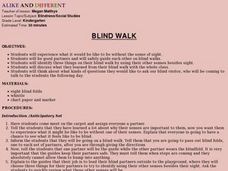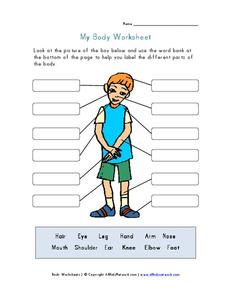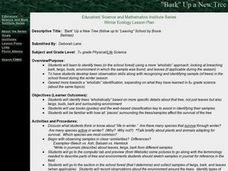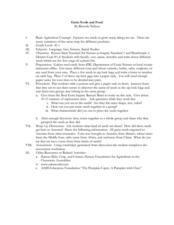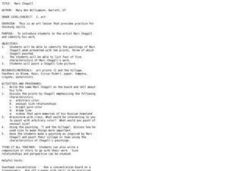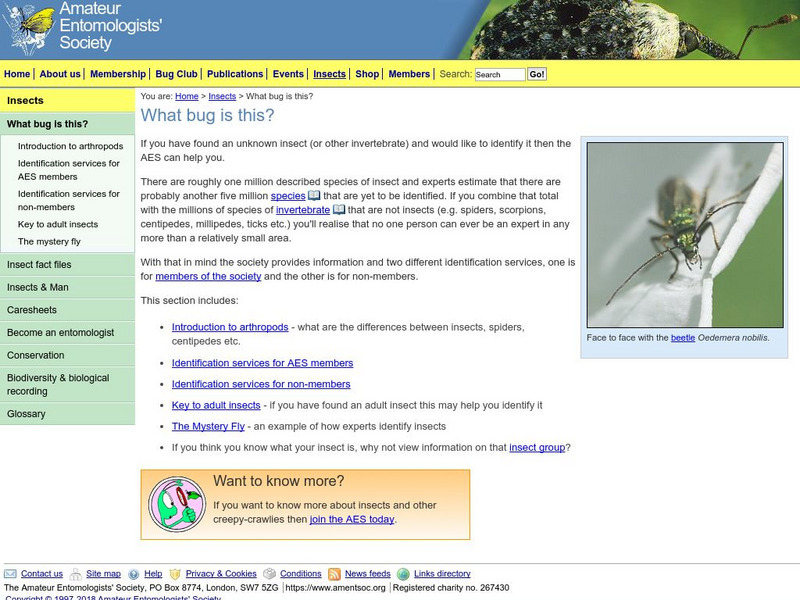Curated OER
Fairly Simple Mineral Identification Exercise
Students perform simple field tests on a variety of minerals and use their results and a given data chart to determine which mineral each specimen is.
Curated OER
Classification of Clouds
Students view a cloud slide show presentation and identify types of clouds. They estimate height based on cloud's appearance. They discuss the vague nature of cloud nomenclature and compare it to the English standard measurement system.
Curated OER
Blind Walk
Students experience what it would be like to live without the sense of sight, identify three things on a blind walk by using senses other than sight, and discuss what they learned from the experience with the whole class.
Curated OER
My Body
In this body parts worksheet, students use a word bank given at the bottom of the page to label body parts shown. A reference web site for additional activities is given.
Curated OER
Create A DNA Fingerprint
Young scholars engage in a lesson that is about the DNA molecule and focuses upon the sequencing of proteins to identify individuals. They conduct research using a variety of resources and then complete the activities included in the 3...
Curated OER
What's Special About Me?
Pupils identify personal strengths that can help them cope with events in life like 9/11. They address two factors that have been demonstrated by research studies to assist students in adapting to and coping with stress. Pupils are...
Curated OER
Farm Animal Friends
Students apply basic communication and math skills to situations. They apply prior knowledge to list characteristics of different animals. They listen to music to engage multiple senses. Then images of animals are shared with them to...
Curated OER
ADULT ESOL LESSON PLANS--Level 2--Obtaining Employment
Students, while extensively reviewing the vocabulary list on the board, identify/examine/produce the proper forms of identification in preparing to obtain employment in the United States.
Curated OER
Identification Required
Young scholars identify the various forms of personal identification cards available in their community. They explain the different uses for each form of identification using "this and that" vocabulary.
Curated OER
GPS Treasure Hunt
Students practice using a GPS receiver and reading directions in an on-campus field trip. Students can identify a building stone, tree, or plant at each stop depending on which area of science is being studied.
Curated OER
"Bark" Up a New Tree
Seventh graders identify trees based on twigs, buds, bark, and surrounding environment. They collect samples from the school and then return to the computer lab and identify the specimans using a specific website. They exchange their...
Curated OER
Grain Seeds and Food
Students observe the characteristics of different seed types. They classify, sort, name and write about the seeds.
Curated OER
Who Am I?
Fourth graders identify and classify insects while working with a live insect. They collect an insect to study.
Curated OER
Marc Chagall
Second graders identify the characteristics of the artwork of Marc Chagall. They paint a Chagall-like picture
Michigan State University
Michigan State University: Biometrics Research
This is a site on the use of biometrics in personal identification. Includes a summary of some of the many types of biometric methods under development.
E-learning for Kids
E Learning for Kids: Science: Scotland: What Are Shadows?
Aggie lives in a cottage near Loch Ness in Scotland. Help her identify shadows and match different objects with their shadows.
Sophia Learning
Sophia: In Groups, Out Groups, and Social Identity Theory: Lesson 2
At the end of this tutorial, the learner will understand how adherence to group norms establishes in- and out- groups and will be able to relate this to Social Identity Theory. It is 2 of 3 in the series titled "In-Groups, Out-Groups,...
Other
Aes: Bug Identification
This interactive resource can be used to identify the order of an insect.
Other
Find Biometrics, Global Identity Management
This site is geared more toward a consumer than a student, but it does list, describe, and in some cases compare each of the primary identification methods (fingerprints, iris recognition, voice, etc).
Other
Your Thoughts Is That Really You?
Biometrics has come to refer to the identification of individuals through distinguishing biological features. This article discusses what that might mean to us as individuals.
Other
The Biometric Consortium
This site provides a very comprehensive look at the current status of biometric systems. There is some information contained directly within the site, but the main feature is the numerous links to each of the different types of biometric...
Other
Ibm: Biometrics
This site from IBM provides a simple introduction to the field of biometrics and includes descriptions with examples for several personal identification and recognition systems (e.g., fingerprints, hand geometry).




